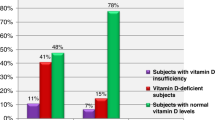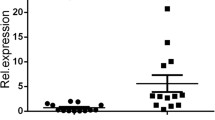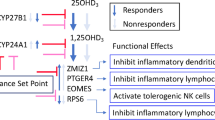Abstract
Purpose
Turner syndrome (TS) patients display considerable immune misregulation, and it is hypothesized that Vitamin D (VTD) activity may fluctuate according to Vitamin D receptor (VDR) polymorphisms and/or expression profile. To uncover a possible relationship between VDR genotype and clinical conditions in TS patients, we investigated two functional VDR variants (Cdx-2 and FokI) for allele and genotype frequencies, as well as expression profile in TS individuals versus healthy controls (HC).
Methods
We performed a genetic association study including 100 TS patients and 116 HC. Genotyping for VDR Cdx-2 G > A (rs11568820) and FokI C > T (rs2228570) was performed using Taqman Genotyping Assays. VDR gene expression was also evaluated in 15 TS and 15 HC, using fluorogenic probes by qPCR. Statistical analyses were performed using nonparametric Mann–Whitney test, with a 5% significance level (p < 0.05) to uncover differences between groups. In addition, we investigated whether shifted VDR mRNA levels were associated with Cdx-2 and FokI variants in TS patients.
Results
We detected a significantly higher frequency of T allele (p = 0.006) as well as T/T genotype (p = 0.01) for FokI in TS patients when compared to HC. When assessing VDR expression, we identified a downregulation in TS woman (− 2.84 FC) versus HC (p < 0.001). Furthermore, C/T (11.24 FC; p = 0.01) and T/T (9.20 FC; p = 0.01) FokI genotypes were upregulated when compared to C/C reference genotype.
Conclusion
TS patients show different distribution of FokI polymorphism. Downregulation of VDR gene expression may contribute to immunological imbalance in TS.


Similar content being viewed by others
References
Stochholm K, Juul S, Juel K, Naeraa RW, Gravholt CH (2006) Prevalence, incidence, diagnostic delay, and mortality in Turner syndrome. J Clin Endocrinol Metabol 91:3897–3902. https://doi.org/10.1210/jc.2006-0558
Gravholt CH, Andersen NH, Conway GS, Dekkers OM, Geffner ME, Klein KO (2017) Clinical practice guidelines for the care of girls and women with Turner syndrome: proceedings from the 2016 Cincinnati International Turner Syndrome Meeting. Eur J Endocrinol 177:G1–G70. https://doi.org/10.1530/EJE-17-0430
Jørgensen KT, Rostgaard K, Bache I, Biggar RJ, Nielsen NM, Tommerup N, Frisch M (2010) Autoimmune diseases in women with Turner’s syndrome. Arthritis Rheum 62:658–666. https://doi.org/10.1002/art.27270
Bakalov VK, Gutin L, Cheng CM, Zhou J et al (2012) Autoimmune disorders in women with turner syndrome and women with karyotypically normal primary ovarian insufficiency. J Autoimmun 38:315–321. https://doi.org/10.1016/j.jaut.2012.01.015
Grossi A, Crinò A, Luciano R, Lombardo A, Cappa M, Fierabracci A (2013) Endocrine autoimmunity in Turner syndrome. Italian J Pediatr 39:79. https://doi.org/10.1186/1824-7288-39-79
Witkowska-Sędek E, Borowiec A, Kucharska A et al (2017) Thyroid autoimmunity in girls with Turner syndrome. Advances Exp Med Biol 1022:71–76. https://doi.org/10.1007/5584_2017_42
Livadas S, Xekouki P, Fouka F et al (2005) Prevalence of thyroid dysfunction in Turner’s syndrome: a long-term follow-up study and brief literature review. Thyroid 15:1061–1066. https://doi.org/10.1089/thy.2005.15.1061
Gawlik A, Gawlik T, Januszek-Trzciakowska A, Patel H, Malecka-Tendera E (2011) Incidence and dynamics of thyroid dysfunction and thyroid autoimmunity in girls with Turner’s syndrome: a long-term follow-up study. Hormone Res Paediatr 76:314–320. https://doi.org/10.1159/000331050
Guillot X, Semerano L, Saidenberg-Kermanac’h N, Falgarone G, Boissier MC (2010) Vitamin D and inflammation. Jt Bone Spine 77:552–557. https://doi.org/10.1016/j.jbspin.2010.09.018
Kamen DL, Tangpricha V (2010) Vitamin D and molecular actions on the immune system: modulation of innate and autoimmunity. J Mol Med 88:441–450. https://doi.org/10.1007/s00109-010-0590-9
Holick MF (2017) The vitamin D deficiency pandemic: approaches for diagnosis, treatment and prevention. Rev Endocr Metab Disord 18:153–165. https://doi.org/10.1007/s11154-017-9424-1
Bouillon R, Carmeliet G, Verlinden L et al (2008) Vitamin D and human health: lessons from vitamin D receptor null mice. Endocr Rev 29:726–776. https://doi.org/10.1210/er.2008-0004
Baeke F, Takiishi T, Korf H, Gysemans C, Mathieu C (2010) Vitamin D: modulator of the immune system. Curr Opin Pharmacol 10:482–496. https://doi.org/10.1016/j.coph.2010.04.001
Uitterlinden AG, Fang Y, Van Meurs JB, Pols HA, Van Leeuwen JP (2004) Genetics and biology of vitamin D receptor polymorphisms. Gene 338:143–156. https://doi.org/10.1016/j.gene.2004.05.014
Peralta López M, Miras M, Silvano L et al (2011) Vitamin D receptor genotypes are associated with bone mass in patients with Turner syndrome. J Pediat Endocrinol Metabol 24:307–312. https://doi.org/10.1515/jpem.2011.047
Peralta López M, Centeno V, Miras M et al (2012) Association of vitamin D receptor gene Cdx2 polymorphism with bone markers in Turner syndrome patients. J Pediat Endocrinol Metabol 25:669–671. https://doi.org/10.1515/jpem-2012-0098
Bianco B, Verreschi IT, Oliveira KC et al (2012) Analysis of vitamin D receptor gene (VDR) polymorphisms in Turner syndrome patients. Gynecol Endocrinol 28:326–329. https://doi.org/10.3109/09513590.2011.631630
World Medical Association (2012) Declaration of Helsinki: ethical principles for medical research involving human subjects. JAMA 310:2191–2194
McGowan-Jordan J, Simons A, Schmid M (2016) ISCN: an international system for human cytogenomic nomenclature. Karger, Basel
Livak KJ, Schmittgen TD (2001) Analysis of relative gene expression data using real-time quantitative pCR and the 2−ΔΔCt method. Methods 25:402–408. https://doi.org/10.1006/meth.2001.1262
Su MA, Stenerson M, Liu W et al (2009) The role of X-linked FOXP3 in the autoimmune susceptibility of Turner Syndrome patients. Clin Immunol 131:139–144. https://doi.org/10.1016/j.clim.2008.11.007
Coelho AVC, Moura RR, Cavalcanti CAJ, Guimarães RL, Sandrin-Garcia P, Crovella S, Brandão LAC (2015) A rapid screening of ancestry for genetic association studies in an admixed population from Pernambuco, Brazil. Genet Mol Res 14:2876–2884. https://doi.org/10.4238/2015.March.31.18
Yang CY, Leung PS, Adamopoulos IE, Gershwin ME (2013) The implication of vitamin D and autoimmunity: a comprehensive review. Clin Rev Allergy Immunol 45:217–226. https://doi.org/10.1007/s12016-013-8361-3
Liel Y, Shany S, Smirnoff P, Schwartz B (1999) Estrogen increases 1,25-dihydroxyvitamin D receptors expression and bioresponse in the rat duodenal mucosa. Endocrinol 140:280–285. https://doi.org/10.1210/endo.140.1.6408
Gravholt CH (2004) Epidemiological, endocrine and metabolic features in Turner syndrome. Europ J Endocrinol 151:657–687. https://doi.org/10.1530/eje.0.1510657
Suenaga R, Evans MJ, Mitamura K, Rider V, Abdou NI (1998) Peripheral blood T cells and monocytes and B cell lines derived from patients with lupus express estrogen receptor transcripts similar to those of normal cells. J Rheumatol 25:1305–1312
Straub RH (2007) The complex role of estrogens in inflammation. Endocr Rev 28:521–574. https://doi.org/10.1210/er.2007-0001
Arai H, Miyamoto K, Taketani Y et al (1997) A Vitamin D Receptor gene polymorphism in the translation initiation codon: effect on protein activity and relation to bone mineral density in Japanese Women. J Bone Miner Res 12:915–921. https://doi.org/10.1359/jbmr.1997.12.6.915
Elsheikh M, Wass JAH, Conway GS (2001) Autoimmune thyroid syndrome in women with Turner’s syndrome—the association with karyotype. Clin Endocrinol 55:223–226
Gawlik AM, Elzbieta Berdej-Szczot E, Blat D, Klekotka R, Gawlik T, Blaszczyk E, Hankus M, Malecka-Tendera E (2018) Immunological profile and predisposition to autoimmunity in girls with Turner Syndrome. Front Endocrinol 9:307. https://doi.org/10.3389/fendo.2018.00307
Acknowledgements
The authors wish to thank the patients, parents, and clinicians for availability that facilitated our data acquisition.
Funding
This research was supported by Fundação de Amparo a Ciência e Tecnologia do Estado de Pernambuco (FACEPE) and by Universidade Federal de Pernambuco (UFPE).
Author information
Authors and Affiliations
Corresponding author
Ethics declarations
Conflict of interest
The authors have no conflicts of interest to declare.
Ethical approval
This work was approved by the Ethics Committee on Research in Human of the Institute of Integral Medicine Prof. Fernando Figueira (CEP-IMIP-Record: CEP/IMIP N° 802/06) and the Research Ethics Committee of Health Sciences Centre (CEP/CCS/UFPE-CAAE: 71308817.8.0000.5208).
Informed consent
Informed consent was obtained from all individuals participant included in this study.
Additional information
Publisher's Note
Springer Nature remains neutral with regard to jurisdictional claims in published maps and institutional affiliations.
Electronic supplementary material
Below is the link to the electronic supplementary material.
Rights and permissions
About this article
Cite this article
Santos, L.O., Laranjeira, R., Borborema, M.E.B.A. et al. Vitamin D receptor (VDR) gene polymorphisms and expression profile influence upon the immunological imbalance in Turner syndrome. J Endocrinol Invest 43, 505–513 (2020). https://doi.org/10.1007/s40618-019-01135-1
Received:
Accepted:
Published:
Issue Date:
DOI: https://doi.org/10.1007/s40618-019-01135-1




